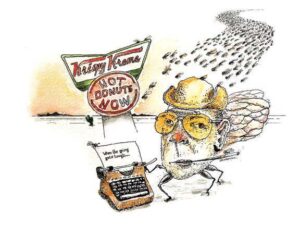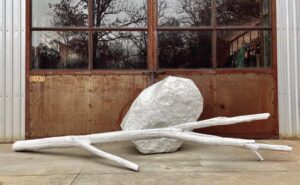
Made in the U.S.A.
But how?
By Deborah Salomon
The way I understand it, after the Industrial Revolution engineers emerged who could design a machine to perform any task, make almost anything: put toothpaste into tubes, peas into cans, ketchup into bottles. Tires and engine parts scooted off an assembly line. Pills were formed, counted and routed into containers. Buttons were sewn onto shirts with a hammering needle.
Making the machines that made the products became an industry itself — the tool and die trade. We hardly consider the ways and means anymore when purchasing socks or soda, books or baseballs. Metal is molded a million ways, from body parts to car parts. Plastic? Don’t ask.
I’m not too concerned with the mechanism that catapults a spacecraft toward the moon, but as I stare down into a bowl of Cheerios I wonder
. . . do they concoct a sludge of oats, sugar, whatever and pour it into a mold with a trillion little O indentations? What then? Baked, dumped into a silo, I suppose.
Then, the eternal mystery of the aerosol can. If the cream goes in as a liquid, why can’t I hear it swoosh when I shake a full can? Does the gas pressing down silence the cream?
America’s insatiable desire to demystify the wrapping of Hershey Kisses (why the name?) has been assuaged by a display at two factories where machines wrap 33 million a day. But I still don’t know why or how Pringles and other “stackable” potato chips come about.
From a logical standpoint, a potato chip should be made from a potato sliced paper thin, then deep fried — a grand total of two processes if you omit peeling, which is entirely unnecessary. But who wants logical, when the alternative has been peeled, pulverized, flavored, adulterated, formed, fried before the chip clones are stacked in a cylinder.
OK, maybe the package takes up less room in the pantry. But the integrity of the potato is lost.
Oreos require punching out, embossing, baking, filling with the flavor of the month, sandwiching. Makes the machine that pits olives and cherries seem like child’s play.
I found some vindication watching kindly old Italian women hand-twisting tortellini in a Venetian pasta factory. Hope their insurance covers carpal tunnel syndrome. One reason crabmeat is so expensive is that picking out shells remains a task best performed by human eyes and hands.
Speaking of pasta, picture the gadget that extrudes angel hair, the finest strand, and slides the right weight strands into the box, unbroken.
Wouldn’t you love to see the machine that affixes bobby pins to the card?
Here’s the kicker: half a dozen educational TV channels have been trying forever to figure out how the great pyramids were built (the latest being an interior spiral roadway designed by space aliens) without agreeing on a method. Yet, after putting in only two letters my cell phone knows what word I want and insists on being right, rejecting any unfamiliar spelling. Maddening.
Sometimes, capabilities go too far. In his Western movie days, Ronald Reagan popularized “stonewashed” jeans attained after hundreds of wearings and washings. Denim-meisters figured, why wait? So they dumped new jeans into giant metal cylinders laden with rough stones, including pumice. Rotating the cylinders subjected fabric to abrasion. When pumice became scarce, manufacturers turned to cellulose enzymes. Sandblasting promoted fading and fraying. I don’t want to know how they accomplish threadbare knees. Those opposed to cruel and unusual punishment perpetrated against denim hired cowboys to wear a new pair for a year or so. Not really. But used jeans stores were the rage back in the ’70s. Most precious were specimens with the outline of a Marlboro hardpack on the seat pocket, à la the Shroud of Turin.
Some machine-assisted tasks have been immortalized (mocked?) in the American lexicon, like “the greatest invention since sliced bread.” All I know is if the Egyptians could figure out pyramid construction and keep the secret, think how they could improve Cheerios, not to mention Levis.
Yet they consumed barley and spelt, figs and dates, wine but little meat. And they wore simple linen tunics while performing tasks no electronic or human brain can fathom.
Hmm . . . PS
Deborah Salomon is a staff writer for PineStraw and The Pilot. She may be reached at debsalomon@nc.rr.com.





